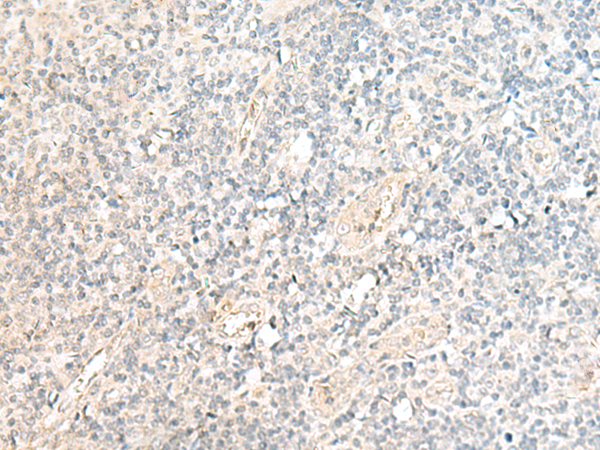

| WB | 咨询技术 | Human,Mouse,Rat |
| IF | 咨询技术 | Human,Mouse,Rat |
| IHC | 1/40-1/200 | Human,Mouse,Rat |
| ICC | 技术咨询 | Human,Mouse,Rat |
| FCM | 咨询技术 | Human,Mouse,Rat |
| Elisa | 1/5000-1/10000 | Human,Mouse,Rat |
| Aliases | SMD1; SNRPD; Sm-D1; HsT2456 |
| Host/Isotype | Rabbit IgG |
| Antibody Type | Primary antibody |
| Storage | Store at 4°C short term. Aliquot and store at -20°C long term. Avoid freeze/thaw cycles. |
| Species Reactivity | Human, Mouse |
| Immunogen | Fusion protein of human SNRPD1 |
| Formulation | Purified antibody in PBS with 0.05% sodium azide and 50% glycerol. |
+ +
以下是关于SNRPD1抗体的3篇参考文献概览:
---
1. **文献名称**:SNRPD1 is a key mediator of tamoxifen resistance in breast cancer
**作者**:Li X, et al.
**摘要**:该研究通过Western blot和免疫组化分析,发现SNRPD1在乳腺癌他莫昔芬耐药细胞中高表达。使用特异性抗体验证了其通过调控剪接体功能促进耐药性的机制。
2. **文献名称**:Autoantibodies against spliceosomal components in systemic lupus erythematosus
**作者**:Satoh M, et al.
**摘要**:研究系统性红斑狼疮患者血清中抗剪接体抗体的特征,其中SNRPD1抗体被鉴定为重要标志物,通过ELISA和蛋白质印迹法证实其与疾病活动的相关性。
3. **文献名称**:SNRPD1 depletion inhibits tumorigenesis in pancreatic cancer via cell cycle arrest
**作者**:Wang Y, et al.
**摘要**:利用SNRPD1抗体进行免疫沉淀和免疫荧光实验,证明敲低SNRPD1可通过阻滞细胞周期抑制胰腺癌细胞增殖,提示其作为潜在治疗靶点。
---
以上文献展示了SNRPD1抗体在癌症机制、自身免疫疾病诊断及靶向治疗研究中的应用。如需扩展可补充具体发表年份或期刊信息。
**Background of SNRPD1 Antibody**
SNRPD1 (Small Nuclear Ribonucleoprotein D1) is a core component of the spliceosome, a macromolecular complex essential for pre-mRNA splicing. It is part of the Sm protein family, which assembles into the Sm core of small nuclear ribonucleoproteins (snRNPs) that recognize splice sites on pre-mRNA. SNRPD1 plays a critical role in maintaining spliceosome stability and ensuring accurate splicing, a process vital for gene expression regulation.
Antibodies targeting SNRPD1 are widely used in research to study spliceosome assembly, RNA processing mechanisms, and their dysregulation in diseases. For example, abnormal splicing due to SNRPD1 dysfunction has been linked to cancers, neurodegenerative disorders, and autoimmune conditions. In systemic lupus erythematosus (SLE), autoantibodies against SNRPD1 are common diagnostic markers, highlighting its clinical relevance.
SNRPD1 antibodies are employed in techniques like Western blotting, immunoprecipitation, and immunofluorescence to detect protein expression, localization, and interactions. They are often validated for specificity using knockdown/knockout controls or mass spectrometry. Available as monoclonal or polyclonal variants from hosts like rabbit or mouse, these antibodies are crucial tools for exploring splicing mechanisms, cellular stress responses, and therapeutic targets in splicing-related pathologies. Researchers also use them to investigate SNRPD1's role in cell cycle regulation, apoptosis, and its potential as a biomarker in disease progression.
×